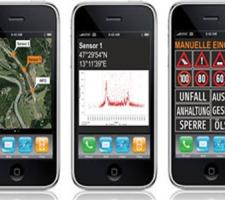
ASFINAG has developed a mobile traffic monitoring and guidance system through a pre-commercial procurement project.
Drivers have become accustomed to roadside and gantry-mounted traffic guidance and control systems along the major roads and main motorway sections. But there are occasions when intense monitoring is required on a temporary basis along motorway sections without traffic guidance and control systems and on federal and national roads too. Examples include the monitoring of the traffic flow during road works or at big events.
To cater for these temporary events the Autobahnen- und Schnellstraßen-Finanzierungs-Aktiengesellschaft (
In order to identify a solution, ASFINAG conducted a pre-commercial procurement (PCP) project in cooperation with the Austrian Ministry for Transport, Innovation and Technology.
An essential element of the PCP project is for multiple competing companies to develop different, innovative solutions to the given problem. The process has multiple consecutive phases starting with the call for proposals followed by feasibility studies and then prototype development. At the end of each phase there is a selection / reduction of bidders remaining in the competition.
In this case seven project proposals were submitted in the first phase, out of which five were chosen for a feasibility study. Of these five consortiums, two (‘Move Best’ and ‘Movebag’) were selected to develop a prototype for testing on ASFINAG’s network.
Move Best has been developed by EBE Solutions, the Austrian Institute of Technology and Verkehrspuls – Technisches Büro für Verkehrsplanung, while Prisma solutions,
Both prototypes include a combination of mobile, energy-efficient and dynamically controllable components for the collection, transmission and display of traffic data. Two people can easily erect the mobile sensors (radar, Bluetooth and CCTV) on-site to collect information such as vehicle numbers, speed and passing times as well as video imaging.
With both contenders, the mobile traffic management system sends the raw data to either the existing permanent or a temporary traffic control centre for interpretation and analyses using a number of defined algorithms. All data is available online and can be viewed as a map in the control centre. Based on the traffic situation, the operator can remotely configure the information on the mobile display boards to inform road users about the current traffic situation and possible alternative routes.
Both systems have a modular concept and can be transported in sections using an ASFINAG service vehicle. Once deployed the battery-powered systems can operate for up to a week without recharging.
When a bigger traffic disruption or obstruction is planned or reported, the operation team dispatch the system to the relevant locations to set up the mobile display boards and erect the sensors. The precise location is decided by the responsible employee on-site according to the configuration of the road and any obstacles such as roadworks.
Once in operation the real-time data collected by the sensors, including the exact location of all units, is transmitted to the central system via GSM (global system for mobile communications) or UTMS (universal mobile telecommunications system).
The first test results were very positive and further trials in live operation are being assessed. The highlight of the tests was the deployment of the mobile traffic management system on the roads leading to the Red Bull Ring during the 2015 Formula 1 Grand Prix in Austria. Based on the results, the procurement of two additional systems is envisaged.
The phased realisation of the pilot project guaranteed the systems exactly met the requirements while allowing both competition and quality assurance, and minimising project risks.













